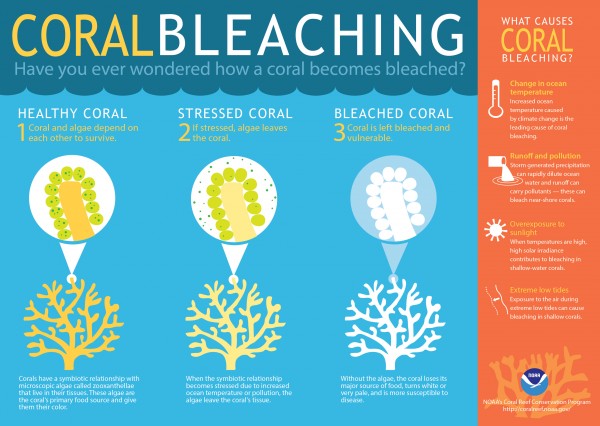
Last week, (October 8) the National Oceanic and Atmospheric Administration (NOAA) declared the third global coral bleaching event on record. As high ocean temperatures cause widespread coral bleaching across Hawaii, NOAA scientists confirm the same stressful conditions are expanding to the Caribbean and may last into the new year.
The first global bleaching event known to scientists was in 1998, during a strong El Niño that was followed by an equally very strong La Niña. A second one occurred in 2010.
Coral bleaching happens when corals are stressed by changes in conditions such as temperature, light, or nutrients, they expel the symbiotic algae living in their tissues, causing them to turn completely white.

Waters are warming in the Caribbean, threatening coral in Puerto Rico and the U.S. Virgin Islands, NOAA scientists said. Coral bleaching began in the Florida Keys and South Florida in August, but now scientists expect bleaching conditions there to diminish.
Mark Eakin is NOAA’s Coral Reef Watch coordinator. Eakin said:
The coral bleaching and disease, brought on by climate change and coupled with events like the current El Niño, are the largest and most pervasive threats to coral reefs around the world.
As a result, we are losing huge areas of coral across the U.S., as well as internationally. What really has us concerned is this event has been going on for more than a year and our preliminary model projections indicate it’s likely to last well into 2016.
While corals can recover from mild bleaching, severe or long-term bleaching is often lethal. After corals die, reefs quickly degrade and the structures corals build erode. This provides less shoreline protection from storms and fewer habitats for fish and other marine life, including ecologically and economically important species.
This bleaching event, which began in the north Pacific in summer 2014 and expanded to the south Pacific and Indian oceans in 2015, is hitting U.S. coral reefs disproportionately hard. NOAA estimates that by the end of 2015, almost 95 percent of U.S. coral reefs will have been exposed to ocean conditions that can cause corals to bleach.
The biggest risk right now is to the Hawaiian Islands, where bleaching is intensifying and is expected to continue for at least another month. Areas at risk in the Caribbean in coming weeks include Haiti, the Dominican Republic and Puerto Rico, and from the U.S. Virgin Islands south into the Leeward and Windward islands.

The next concern is the further impact of the strong El Niño, which climate models indicates will cause bleaching in the Indian and southeastern Pacific Oceans after the new year. This may cause bleaching to spread globally again in 2016.
“We need to act locally and think globally to address these bleaching events. Locally produced threats to coral, such as pollution from the land and unsustainable fishing practices, stress the health of corals and decrease the likelihood that corals can either resist bleaching, or recover from it,” said Jennifer Koss, NOAA Coral Reef Conservation Program acting program manager. “To solve the long-term, global problem, however, we need to better understand how to reduce the unnatural carbon dioxide levels that are the major driver of the warming.”
This announcement stems from the latest NOAA Coral Reef Watch satellite coral bleaching monitoring products, and was confirmed through reports from partner organizations with divers working on affected reefs, especially the XL Catlin Seaview Survey and ReefCheck. NOAA Coral Reef Watch’s outlook, which forecasts the potential for coral bleaching worldwide several months in the future, predicted this global event in July 2015.
Enjoying EarthSky? Sign up for our free daily newsletter today!
Bottom line: On October 8, 2015 NOAA declared the third global coral bleaching event on record. As record high ocean temperatures cause widespread coral bleaching across Hawaii, NOAA scientists confirm the same stressful conditions are expanding to the Caribbean and may last into the new year.











